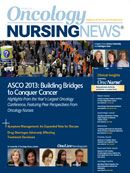Promoting HPV Vaccination for Girls and Boys
Oncology nurses can lead the way in efforts to protect the next generation from this type of cancer if they know the facts about HPV vaccination for both girls and boys
Tami L. Thomas,
PhD, CPNP, RNC, FAANP
Katherine Yeager,
PhD, RN
Oncology nurses have a great opportunity to prevent cancer—not just treat it! Media outlets recently reported Michael Douglas’ diagnosis of throat cancer and his statement that human papillomavirus virus (HPV) infection caused his cancer. Oncology nurses can lead the way in efforts to protect the next generation from this type of cancer if they know the facts about HPV vaccination for both girls and boys.
HPV is the most commonly acquired sexually transmitted infection (STI) in the United States for individuals aged 16 to 24, according to the Centers for Disease Control and Prevention (CDC). It is so common that at least 50% of sexually active men and women acquire this infection at some point in their lives. Unlike many other STIs, HPV can be spread through skin-to-skin contact during sexual play as well as through all types of intercourse.
Most people with HPV do not develop symptoms or health problems, so they may not even know they have the infection. In 90% of cases, the body’s immune system clears HPV naturally within 2 years. However, four of the 40 HPV strains have been linked with cervical cancer. Chronic HPV infection of one specific subtype (DNA subtype 16) has been associated with cervical cancer and cancers of the mouth, throat, head, and neck.
HPV-related cancers can be prevented through HPV vaccination, which is approved for both men and women. The effectiveness of the HPV vaccination for females has recently been shown to be better than expected.1 However, HPV infection is not just a concern for women. HPV currently is estimated to infect young men 20 years of age and older at rates between 65% and 93% in highrisk populations and up to 45% among lower-risk populations.
Unfortunately, the benefit of the HPV vaccine in boys is often overlooked by the initial focus and marketing of the HPV vaccine as a means to prevent cervical cancer. Vaccinating boys and men aged 9-26 years can prevent more than 40,000 cancer-related deaths over the next century, while saving $25,700 per quality-adjusted life-year.2 Unfortunately, despite the usefulness of the vaccine in preventing HPV-related cancers in men, barriers to HPV vaccination still persist.
To increase vaccination rates for boys, nurses can use family-centered strategies to increase parents’ knowledge of HPV vaccination,3 including awareness of the new HPV immunization guidelines from the Advisory Committee on Immunization Practice (ACIP) at the CDC. These guidelines recommend three doses over 6 months, with the second dose given 1-2 months after the first, and the third dose given 6 months after the first dose for boys and girls aged 11 or 12 years old.4 It is also critical to establish parental awareness of the pathology associated with HPV, including the increasing rates of mouth, head, and neck cancers secondary to HPV infection.5
In order to increase vaccination of adolescent males, all adults—and especially men, fathers, and father figures—must understand that HPV infection and related HPV cancers are not just “women’s diseases.” The HPV vaccine is just as important for the future health of a boy as it is for a girl. In addition, studies show that HPV vaccination does not promote sexual promiscuity as many people have thought or feared—an important point to include in patient education.
The Nell Hodgson Woodruff School of Nursing at Emory University is studying how to break down barriers to vaccination, especially in hardto- reach populations such as families living in rural areas. Assistant professor Tami Thomas has been conducting cancer prevention research in rural communities with a focus on a communitybased, participatory approach. Since 2008, she has engaged parents, pastors, teachers, and community leaders to understand why parents choose to vaccinate their children with the HPV vaccine. Her next step includes development of a culturally specific intervention to increase vaccination rates.5
Oncology nurses will no longer just be treating HPV-related cancers, but instead working to prevent cancer. All nurses have a role in informing parents that HPV vaccination can prevent cancers for both girls and boys.
References
- Markowitz LE, Hariri S, Lin C, et al. Reduction in human papillomavirus (HPV) prevalence among young women following HPV vaccine introduction in the United States, National Health and Nutrition Examination Surveys, 2003-2010. J Infect Dis. 2013;208(3):385-393.
- Schiller JT, Day PM, Kines RC. Current understanding of the mechanism of HPV infection. Gynecol Oncol. 2010;118(suppl 1):S12-S17.
- Thomas TL, Snell S. Vaccinate boys with the HPV vaccine? Really? J Spec Pediatr Nurs. 2013;18(2):165-169.
- Centers for Disease Control and Prevention. Recommendations on the use of quadrivalent human papillomavirus vaccine in males—Advisory Committee on Immunization Practices (ACIP). MMWR Morb Mortal Wkly Rep. 2011;60(50):1705-1708.
- Thomas TL, Strickland OL, DiClemente R, Higgins M, Haber M. Rural African American parents’ knowledge and decisions about human papillomavirus vaccination. J Nurs Scholarsh. 2012;44(4):358-367.
Shared Model of Care Post-HCT Offers Safe Follow-Up, Reduces Patient Burden
Published: March 19th 2025 | Updated: March 19th 2025Alternating post-HCT care between specialized facilities and local cancer centers produced noninferior non-relapse mortality and similar quality of life to usual care.



